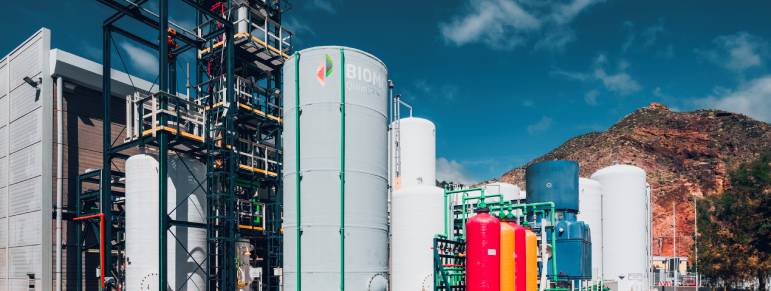The electrolysis process is essential for many industries involved in the production of sodium hypochlorite, which is widely used for water treatment and purification. But how does an electrolysis plant work and what by-products does it generate? This article explores the basic concepts related to this type of technology, its applications and the market potential of what it produces.
What is electrolysis?
Put very simply, electrolysis is the splitting of a compound by means of an electric current. In the context of sodium hypochlorite production, a brine solution (common salt or sodium chloride and water) is split using electrolysis to produce chlorine gas and caustic soda, from which the sodium hypochlorite is subsequently produced.
— Want to know more about electrolysis? See our article Electrolysis: An economical and efficient solution for water purification.
The main components of an electrolysis plant for sodium hypochlorite production
Electrolysis plants are made up of several key elements that work together to ensure efficient and safe production:
- The brine feed system: This system contains the tanks for dissolving and storing the brine and the pumps to transfer it.
- Electrolyzers: This is the equipment where the electrolysis takes place. In the case of our plants, a membrane cell system also referred to as ion exchange membrane electrolysis is used.
- Control systems: Control modules are used to regulate the electric current and monitor the operating conditions in order to optimize the efficiency and safety of the process.
- Gas treatment system: Equipment for handling and treating the gases produced (chlorine and hydrogen), in order to minimize risks and comply with environmental regulations.
- Storage tanks: For the sodium hypochlorite, hydrochloric acid and sodium hydroxide produced, equipped with systems to maintain the integrity and concentration of the product.
Technologies used
Today’s electrolysis plants mainly use two types of technologies: membrane cells and diaphragm cells. In our case, as previously mentioned, we use membrane cells, as they are more efficient and produce higher purity products.
This system uses a selective ion exchange membrane to separate the anode and cathode compartments, allowing for the selective passage of ions and at the same time avoiding mixing of the chemicals produced at each electrode. .
— — Consult the history and evolution of membrane electrolysis applied to water purification.
The sodium hypochlorite production process
Sodium hypochlorite, a strongly oxidizing chemical compound, is the main production objective of these plants. Due to its fungicidal and bactericidal properties, the main use of sodium hypochlorite is in the purification of water for human consumption, although it is also used as a bleach for textile fibres, and in other sectors for the cleaning and disinfection of swimming pools and other environments. How exactly is it produced?
- Brine preparation: Brine is prepared by first dissolving salt in water, followed by a filtration process to remove impurities and suspended particles and finally an ion exchange process to reduce hardness.
- Electrolysis: The now ultrapurified brine is introduced into an electrolyzer, where an electric current is applied. This produces the electrolytic decomposition of the salt solution in water and facilitates the formation of several by-products: sodium hydroxide (NaOH), chlorine gas (Cl2) and hydrogen gas (H2).
- Generation of sodium hypochlorite: The chlorine gas is then reacted with part of the previously generated sodium hydroxide, to form sodium hypochlorite (NaOCl).
By-products and their use
In addition to the sodium hypochlorite mentioned above, our plants also produce:
- Sodium Hydroxide (NaOH): Also known as caustic soda, which is widely used in industry for the manufacture of paper and cellulose, detergents and as a chemical declogger.
- Chlorine Gas (Cl2): Used in the manufacture of PVC, industrial disinfectants and in water treatment.
- Hydrogen Gas (H2): Used as a fuel, in industrial hydrogenation processes and increasingly in clean energy technologies.
Regulations and Safety
The handling of sodium hypochlorite and the gases involved in its production are regulated by local and international standards to ensure operational and environmental safety:
- Safety regulations: These include protocols for handling chlorine gas and hydrogen, which are both highly volatile and require special precautions for their storage and handling.
- Environmental standards: These establish limits on gas emissions and waste discharges to protect the environment and ensure the sustainability of operations.
- Quality certifications: Standards such as ISO 9001 can be applied to hypochlorite production to ensure product quality and consistency.
Why use electrolysis for water purification?
The sodium hypochlorite produced by electrolysis is used to make water drinkable because it effectively eliminates pathogens and microorganisms without generating significant secondary contaminants. It is an ideal solution for municipal water treatment plants and small-scale water systems.
Profitability of sodium hypochlorite
The market for sodium hypochlorite, especially sodium hypochlorite produced locally, is growing. Its ultimate profitability depends on several factors, although it is generally a cheaper and more efficient option than other manufacturing methods:
- Electricity cost: Electricity accounts for a significant portion of operating costs. Plants that can access low-cost electricity or generate their own power through renewable sources can be more cost-effective.
- Scalability: Larger capacity plants can spread fixed costs and benefit from economies of scale, reducing the cost per unit of sodium hypochlorite produced.
- Local market: Proximity to consumer markets reduces logistics costs and increases the competitiveness of locally produced hypochlorite against imported products.
Electrolysis for the production of sodium hypochlorite and other by-products plays a crucial role not only in today’s industry, but in the social and economic development of communities around the world. Its ability to generate key chemicals safely and efficiently, while adapting to specific purity and concentration needs, makes it a fundamental technology in the field of applied chemistry and environmental engineering.





